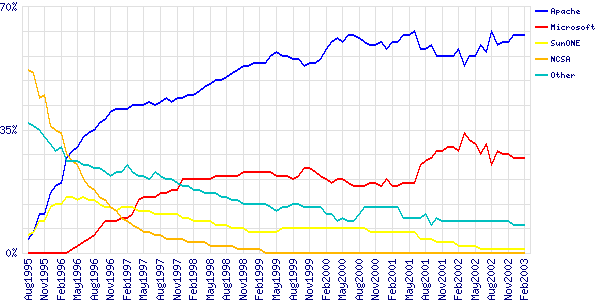The Big Four
As mentioned, there are scores of Web servers available today. Some are free. Some are commercial. Some are heavy-duty; some are light-duty (even personal). Some are highly visible products; others are nearly invisibly embedded within another product. The most heavily used products, as indicated in the graph below, are Apache Web Server, Microsoft IIS, Sun ONE Web Server, and the largest of the “other” group, Zeus Web Server (which in actuality has more active servers than SunONE).
Market Share for Top Servers Across All Domains August 1995 to February 2003
Source: Netcraft (February 2003)
Apache Web servers in combination with the Linux operating system are arguably the most successful of all open-source software. Apache, according to Netcraft, now runs approximately 63 percent of the world’s active Web servers, and its share continues to grow. During 2002 Apache/2.0 made its debut as a major upgrade. Reverberations (tweaks, fixes, and variants) from the upgrade are still being registered. Apache/2.0’s support for threading greatly improved its performance on the Windows platform. This has led to 2.0 being adopted more quickly on Windows than other platforms and has helped Apache chew away at Microsoft’s dominance in the Windows Web server market.
The Apache Software Foundation, the umbrella organization that guides and polices the development of the far-flung Apache code, has numerous development projects continually in progress. The HTTP Server Project (Apache Web Server) has been particularly busy addressing security issues that cropped up during 2002.
Microsoft doesn’t like being number two in anything, much less something as potentially high profile as Web server software, but it’s digging itself out of a hole over issues of security and reliability. With the coming of a new version, IIS 6.0, included in the release of Windows 2003 Server, the company is betting on the demonstration of much-improved security and reliability. IIS has been redesigned (with “significant architectural improvements”) to incorporate XML and Web services specific features as well as improve security. For example, IIS 6.0 will be installed in a “locked-down state,” meaning that maximum security is the default and administrators will need to choose which security measures to relax or remove. IIS 6.0 will also leverage its connections to other Microsoft products that use its services. This will particularly be true of the many Web services features of the Microsoft .NET platform.
Now in version 6.0, the Sun ONE Web Server has gone through many name changes (including iPlanet-Enterprise, Netscape-Enterprise, Netscape-FastTrack, Netscape-Commerce, Netscape-Communications, Netsite-Commerce & Netsite-Communications), which may be indicative of some of its decline in popularity. As might be expected, Sun ONE Web Server has most of its strengths in the close relationship with Java and its support for Java Server Pages and Java Servelets. Sun ONE Web Server is surrounded by a bevy of supporting products (Proxy Server, Directory Server, Portal Server, and Accelerator Board), as well as intimate connections with the Sun ONE Application Server. During 2003, we expect to see an increased amount of direct competition with Microsoft (IIS) and IBM (Apache) in the burgeoning Web services market.
As the third most used server, the Zeus Web Server is the leading example of commercial Web servers geared for the enterprise. Designed for server-farm-style installations, Zeus surrounds its server with an armada of support products that enable it to function in extremely high-performance environments, such as large corporate data centers, ISPs, and Web hosts. Zeus is not alone in catering to these needs, but as a company Zeus Technology is structured to work at this level, and its expertise is probably its biggest asset. The payoff is a Web server that can scale to enormous size and has earned the reputation for relatively easy management and maintenance.
The Web Server Market
Although the struggles for Web server market share are in some ways titanic (or at least from the perspective of Microsoft, Sun, and the open source people), the changes in products are usually incremental and not particularly swift in coming. Apache had a major revision in 2002 and Microsoft will in 2003, but after that, no major changes are planned from either of them for some time — measurable in years.
Consequently, those who follow the products, especially server administrators responsible for making update and patching decisions, must pay attention to the fine details of interim revisions and the various announcements about fixes and patches.
Also, we find that many of the more interesting aspects of the Web server market are not the primary servers, but support and peripheral products such as accelerator boards, cache systems, monitoring software, and various plug-ins that improve performance and make life easier for administrators. Integration with server blades (i.e., densely packed rack-mounted servers) will be a major focus for Web servers in 2003 as enterprises try to consolidate and improve efficiency in the current economic climate.

